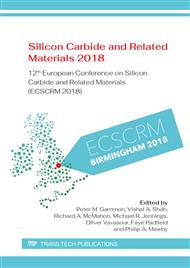[1]
A. J. Lelis, R. Green, D. B. Habersat, and M. El, Basic Mechanisms of Threshold-Voltage Instability and Implications for Reliability Testing of SiC MOSFETs,, IEEE Trans. Electron Devices, vol. 62, no. 2, p.316–323, Feb. (2015).
DOI: 10.1109/ted.2014.2356172
Google Scholar
[2]
M. Okamoto, M. Sometani, S. Harada, H. Yano, and H. Okumura, Dynamic Characterization of the Threshold Voltage Instability under the Pulsed Gate Bias Stress in 4H-SiC MOSFET,, Mater. Sci. Forum, vol. 897, p.549–552, May (2017).
DOI: 10.4028/www.scientific.net/msf.897.549
Google Scholar
[3]
K. Puschkarsky, T. Grasser, T. Aichinger, W. Gustin, and H. Reisinger, Understanding and modeling transient threshold voltage instabilities in SiC MOSFETs,, in 2018 IEEE International Reliability Physics Symposium (IRPS), 2018, pp. 3B.5-1-3B.5-10.
DOI: 10.1109/irps.2018.8353560
Google Scholar
[4]
C. Unger and M. Pfost, Influence of the off-state gate-source voltage on the transient drain current response of SiC MOSFETs,, in 2018 IEEE 30th International Symposium on Power Semiconductor Devices and ICs (ISPSD), 2018, p.48–51.
DOI: 10.1109/ispsd.2018.8393599
Google Scholar
[5]
D. B. Habersat, A. J. Lelis, R. Green, and M. El, Comparison of Test Methods for Proper Characterization of VT in SiC MOSFETs,, Mater. Sci. Forum, vol. 858, p.833–839, May (2016).
DOI: 10.4028/www.scientific.net/msf.858.833
Google Scholar
[6]
K. Puschkarsky, H. Reisinger, T. Aichinger, W. Gustin, and T. Grasser, Understanding BTI in SiC MOSFETs and Its Impact on Circuit Operation,, IEEE Trans. Device Mater. Reliab., vol. 18, no. 2, p.144–153, Jun. (2018).
DOI: 10.1109/tdmr.2018.2813063
Google Scholar
[7]
D. B. Habersat, A. J. Lelis, and R. Green, Measurement considerations for evaluating BTI effects in SiC MOSFETs,, Microelectron. Reliab., vol. 81, p.121–126, Feb. (2018).
DOI: 10.1016/j.microrel.2017.12.015
Google Scholar
[8]
D. B. Habersat, A. J. Lelis, and R. Green, Influences of Bias Interruption and Reapplication on High-Temperature Threshold-Voltage Shifts of SiC DMOSFETs,, Mater. Sci. Forum, vol. 924, p.743–747, Jun. (2018).
DOI: 10.4028/www.scientific.net/msf.924.743
Google Scholar
[9]
Temperature, Bias, and Operating Life, JEDEC Standard JESD22-A108F. (2017).
Google Scholar
[10]
D. B. Habersat, R. Green, and A. J. Lelis, Feasibility of SiC Threshold Voltage Drift Characterization for Reliability Assessment in Production Environments,, Mater. Sci. Forum, vol. 897, p.509–512, May (2017).
DOI: 10.4028/www.scientific.net/msf.897.509
Google Scholar
[11]
T. Aichinger, G. Rescher, and G. Pobegen, Threshold voltage peculiarities and bias temperature instabilities of SiC MOSFETs,, Microelectron. Reliab., vol. 80, p.68–78, Jan. (2018).
DOI: 10.1016/j.microrel.2017.11.020
Google Scholar


